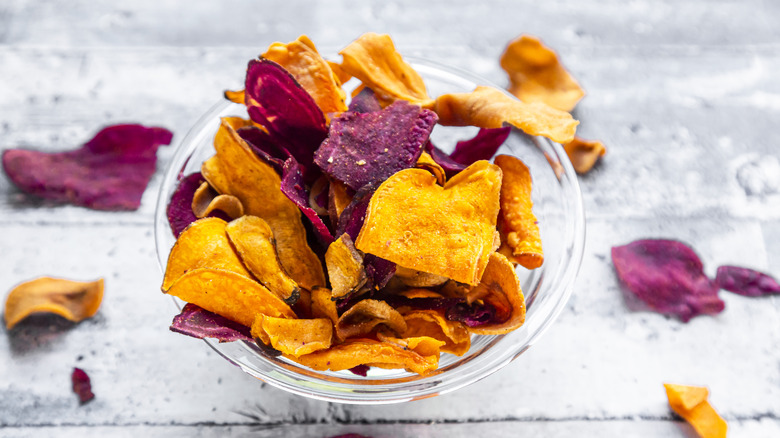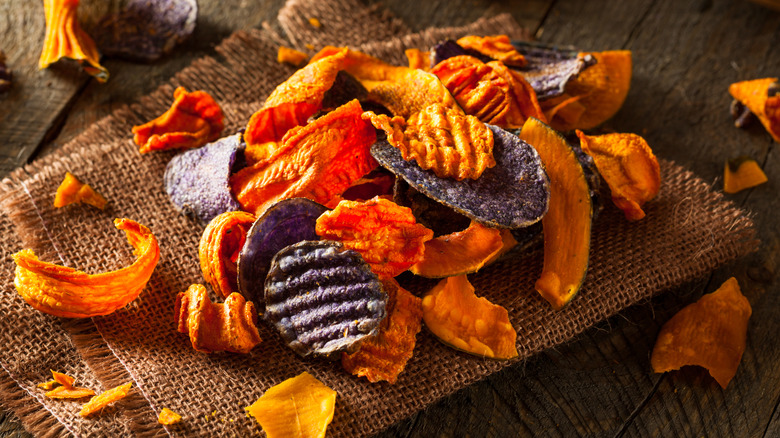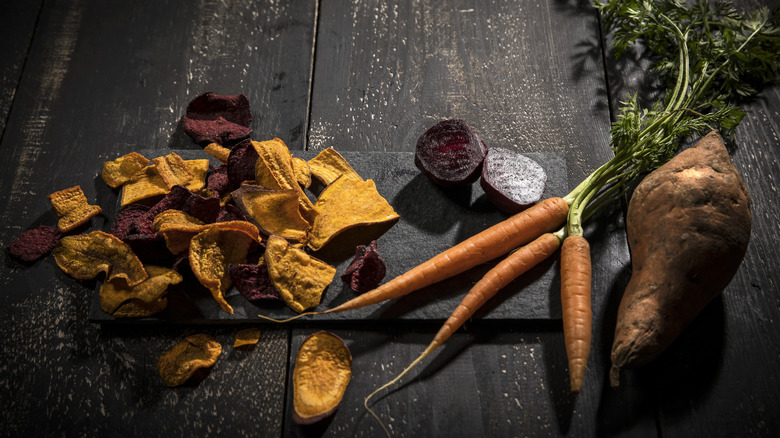Pro Tips For Making The Crispiest Veggie Chips
As far as snacks go, chips are pretty elite. They're the perfect companion to casual movie nights on the couch, sandwich lunches, and even elegant caviar and chip appetizers. And sure, you could head to the grocery store to choose any number of bags to throw in your cart — but you could also step into your own kitchen to make veggie chips that are just as crispy and flavorful as what you can find on the shelves. Costas Spiliadis, founder of Estiatorio Milos, told Food Republic exactly how the vegetable chips at his global collection of Mediterranean seafood restaurants come together.
Before you turn to prep, you have to choose your base. All sorts of vegetables can become chips using largely the same process — many home cooks use root vegetables, like carrots, beets, sweet potatoes, or parsnips because their texture and starch content translate particularly well into chips, but a zucchini chip recipe is also a staple.
Then get your chosen veg ready for the frying oil. "We coat our vegetables in plain flour to add that extra layer of crispness," Spiliadis informed us, "and we dip them in water to make sure the flour really sticks to them." If the food is rich in starch, or you add the batter, coating, or layer of plain flour as Spiliadis suggests, frying will also create a dehydrated starch crust that holds moisture in the interior of the food as it cooks so that it doesn't become too dry. At the same time, the coating will crisp up beautifully in the high heat of the oil.
Trust the frying science for the crunchiest result
It's important to remember, according to Costas Spiliadis, that "[t]here's a lot of chemistry involved in frying something." Basically, frying facilitates the Maillard reaction, which gives food a browned color and distinctive, nutty flavor.
Once the crucial coating is in place, temperature is the next essential element to consider when you're deep-frying at home. Usually, you will start with a higher temperature than you fry at (the food will drop its temp) and it should stay as consistent as possible for even frying (a thermometer is helpful here). Start at 325 to 375 degrees Fahrenheit, so you end up actually frying at 250 to 325. Chef Spiliadis made an important point: "Hold at [a] lower temperature for a crispier result." Doing so allows the batter to cook fully, getting nice and crispy, without burning or overcooking your chips.
To find that sweet spot, Spiliadis suggests that you call on all of your senses. "As a general line, you want to start with sizzling hot oil," he noted. "You almost have to listen to the oil and gradually adjust the intensity of the fire based on the length of the cooking needed. Hold at a lower temperature for a crispier result." It should sound like a soft bubbling — if it's silent, it's too cold. If it's loud, it's probably too hot, and you may burn your oil.
When the veg hits the oil, finish the frying off strong
Frying a small batch of chips each time also helps because they won't lower the temp too much, and they're easier to control in the oil; you want to give them room to breathe so that they don't become one clump. Costas Spiliadis advised us, "Remember to constantly stir and separate the slices in the pot to avoid them sticking together."
A smaller number of chips also makes it easier to see their color and know when they're ready to leave the pot. Spiliadis suggested looking for chips of a golden brown hue that are floating in the oil — when you reach that stage (typically around 2 to 3), they're ready to be removed. This visual process will stand true for most vegetables, but there are exceptions.
"Carrots, for instance," Spiliadis explained, "contain more sugar than others and may turn brown faster even though they have not crisped up yet." You'll need to watch more closely and may have to rely on textural cues rather than visual ones to get those perfectly crunchy results — they should have nicely browned (not burned) edges that are curled up. Once removed, let the chips drain on a paper-towel-lined plate, then add some seasoning to make your extra crispy chips extra special.



